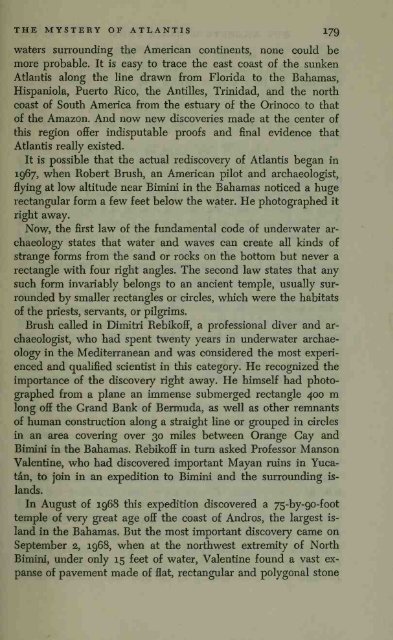Create successful ePaper yourself
Turn your PDF publications into a flip-book with our unique Google optimized e-Paper software.
THE MYSTERY OF ATLANTIS<br />
I79<br />
waters surrounding the American continents, none could be<br />
more probable. It is easy to trace the east coast of the sunken<br />
Atlantis along the line drawn from Florida to the Bahamas,<br />
Hispaniola, Puerto Rico, the Antilles, Trinidad, and the north<br />
coast of South America from the estuary of the Orinoco to that<br />
of the Amazon. And now new discoveries made at the center of<br />
this region offer indisputable proofs and final evidence that<br />
Atlantis really existed.<br />
It is possible that the actual rediscovery of Atlantis began in<br />
1967, when Robert Brush, an American pilot and archaeologist,<br />
flying at low altitude near Bimini in the Bahamas noticed a huge<br />
rectangular form a few feet below the water. He photographed it<br />
right away.<br />
Now, the first law of the fundamental code of underwater archaeology<br />
states that water and waves can create all lands of<br />
strange forms from the sand or rocks on the bottom but never a<br />
rectangle with four right angles. The second law states that any<br />
such form invariably belongs to an ancient temple, usually surrounded<br />
by smaller rectangles or circles, which were the habitats<br />
of the priests, servants, or pilgrims.<br />
Brush called in Dimitri Rebikoff, a professional diver and archaeologist,<br />
who had spent twenty years in underwater archaeology<br />
in the Mediterranean and was considered the most experienced<br />
and quaHfied scientist in this category. He recognized the<br />
importance of the discovery right away. He himself had photographed<br />
from a plane an immense submerged rectangle 400 m<br />
long off the Grand Bank of Bermuda, as well as other remnants<br />
of human construction along a straight line or grouped in circles<br />
in an area covering over 30 miles between Orange Cay and<br />
Bimini in the Bahamas. Rebikoff in tinn asked Professor Manson<br />
Valentine, who had discovered important Mayan ruins in Yucatan,<br />
to join in an expedition to Bimini and the surrounding islands.<br />
In August of 1968 this expedition discovered a 75-by-90-foot<br />
temple of very great age off the coast of Andros, the largest island<br />
in the Bahamas. But the most important discovery came on<br />
September 2, 1968, when at the northwest extremity of North<br />
Bimini, under only 15 feet of water, Valentine found a vast expanse<br />
of pavement made of flat, rectangular and polygonal stone

















